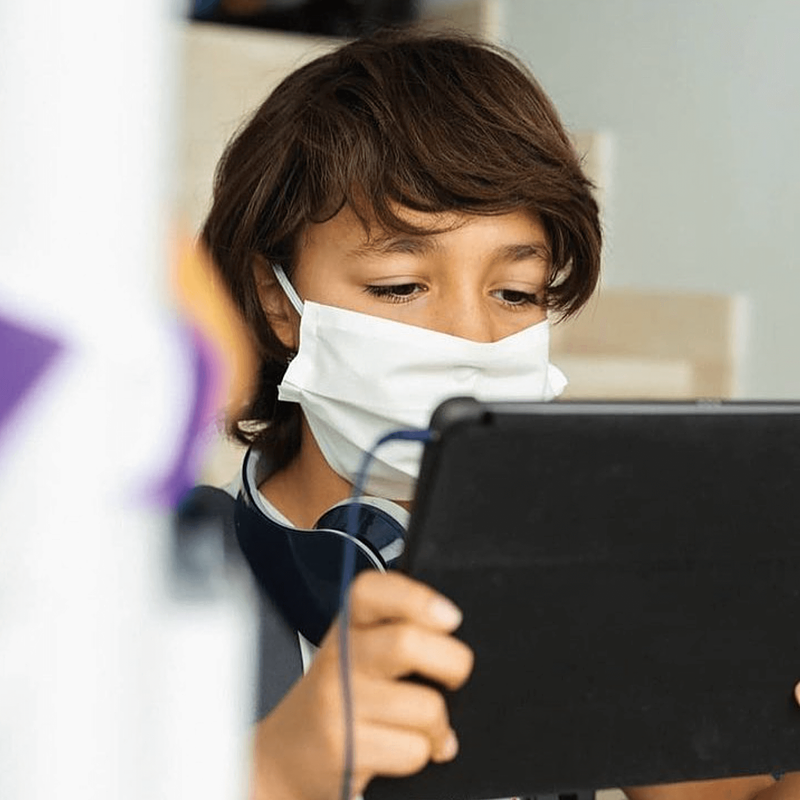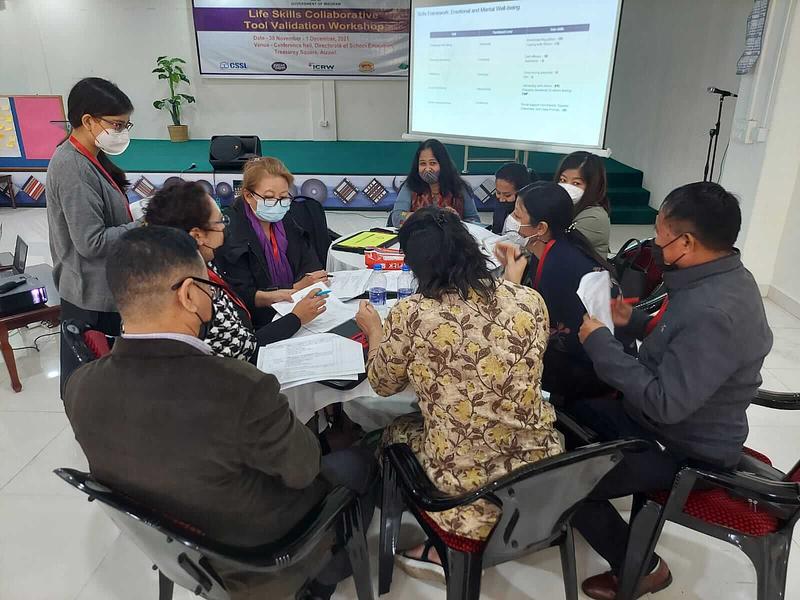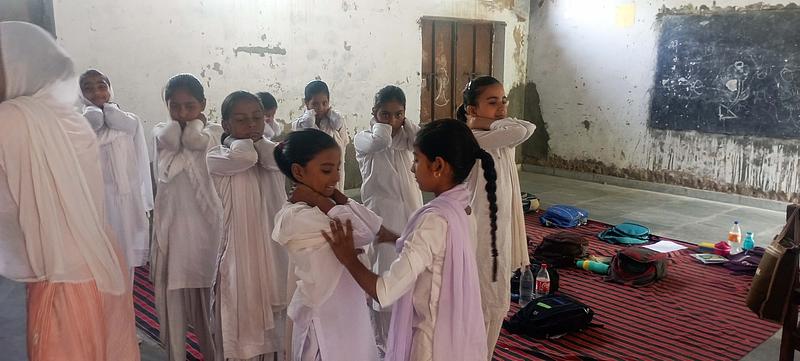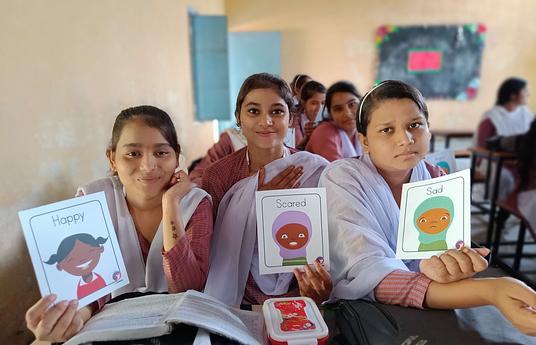Crowdsourcing, the practice of engaging a large group of individuals to contribute to a project or task, has revolutionised various aspects of modern life, from online reviews to Wikipedia entries. But in education, it often raises questions about quality, accountability, and the potential for misuse of student data. Three innovative educational programs from the 2024 Global Collection – LiveBook, A Village Approach to Girls Education from SwaTaleem, and Life Skills Collaborative – demonstrate how aspects of crowdsourcing, carefully targeted, can be powerful tools for enhancing learning outcomes, addressing socio-cultural barriers, and empowering individuals.

Livebook's AI tools help connect student with expertise to students who need extra help
Of the three, LiveBook aligns the most with our traditional understanding of crowdsourcing. The programme is an evolution of the age-old practice of taking notes in the margins of a book. Students are able to share the notes that they take on particular chapters - slide decks, problems, questions, insights, and additional explanations - of their textbooks, which are then coded and indexed by AI. Ultimately, users are able to access a library of information relevant to the topic they are studying, just by pointing their camera at the text.
Ali Mansour, LiveBook’s co-founder and CEO, and his team landed on peer-to-peer content after considering the context of the Iranian educational system. “Unlike third party publishers that dominate the market in developing countries, we wanted to create an approach for accessing resources that gave students agency in choosing the content and style that suited their needs, rather than lucking into a certain teacher or textbook.” And the research bears this out - crowdsourced content is more varied and creative than traditional alternatives. Each participant brings their own inspirations and understanding to table, and LiveBook has over a million students that are working together through the app.

Expertise from diverse backgrounds comes together through LSC in the development of its life skills tools
India’s Life Skills Collaborative (LSC) takes a different approach to synthesising its tools and data. Instead of an external call - open to the public at large, LSC used an internal process, reaching across its 18 member organisations and four state governments to gather expert insights and local knowledge to create a comprehensive multilingual glossary of the life skills tailored for the Indian context as well as assessment tools that help students and teachers measure these intrinsically qualitative skills.
LSC’s lead, Arjun Bahadur, explains why working with such a breadth of groups was necessary for their work to be successful: “It was important for us to develop assessment tools that were contextual to India. Most existing assessment tools for life skills we found were designed in the Global North for the Global North context… The first draft of the definitions for each of [the 52] skills were developed based on literature reviews of relevant research papers. These were then reviewed by over 100 experts from across India who brought in the regional and social contexts into these definitions. These definitions were also developed in 4 languages – English, Hindi, Marathi and Mizo and were reviewed for linguistic and cultural contexts by experts from States that have these languages.” The assessments, which measure student acquisition, teacher preparedness, and system support for the identified life skills, also rely on the consensus of the broad base of experts that gathered together to constitute LSC’s “crowd.” The collaborative’s work places an emphasis on using a broad network of local knowledge and experience alongside vigorous academic and scientific validation to make global concepts useful for students. The result is that the tools are now implemented in schools across three of the partner states.
“Each community member is contributing in clearing the obstacles from our girls' lives.”
For a different view of community networks, consider SwaTaleem. Its programme, A Village Approach to Girls Education, is just that: integrating the stakeholders across a community - teachers, peers, government leaders, families, and respected women - to help girls understand what education is for, and that education is for them. Vaibhav Kumar, SwaTaleem’s Executive Director, says that creating a broad base of support for girls in marginalised communities is important for combating socio-cultural barriers. “The decisions of the girls’ mobility, aspirations, control over important life decisions such as marriage and pregnancy are also highly influenced by these stakeholders. Hence it becomes extremely important to ensure that they become part of this journey of supporting the girls.” And these girls need support - SwaTaleem focuses on those most affected by the overlapping effects of their caste, class, minority status, and gender. The complexity of their challenges requires help from a variety of sources.

SwaTaleem's programme encourages peers to get involved in supporting each others' academic success
SwaTaleem views each of the different members of the community as being able to contribute something different to supporting the girls as they acquire competencies in English; SEL; and life, family and career planning. This “whole village” approach benefits the whole village as well - the girls in the program report significantly increased foundational skills, self esteem, and sense of belonging. Nearly 80% of parents feel more connected to their daughter’s education through regular check-ins (instituted via phone calls that made updates quick, simple and accessible for parents that live in remote regions), and the teachers involved in the programme formed better relationships with each other and themselves leading to concrete improvements in school culture. Vaibhav shares the message at the core of their work: “The role of each community member is pivotal in making the program successful. Each community member is contributing in clearing the obstacles from our girls' lives.”
"The more we gave these students a space to shine, the more they would embrace it"
This, perhaps, is the true heart of innovations that turn to wider groups for their work: these are organisations that make space for everyone to contribute, and for everyone’s work to matter. LiveBook gives students a platform to share, Ali says, “The lesson here was the more we gave these students a space to shine the more they would embrace it, correlating directly with their increased sense of confidence. The other students would also use the content of their peers heavily for revisions. What at first started as the excitement of seeing their friends 'in an app' quickly turned into an opportunity for more relevant learning material… When COVID hit we realised that this was the perfect opportunity to scale this approach. As demand for tutoring rose, so did the prices, and many students couldn't afford the costly sessions. We quickly launched a peer-tutorship platform where older students could tutor younger students in groups of two or three at a fraction of a price. This approach capitalised on the benefits we observed for both the peer-teacher and peer-learner; on the one hand it provided the peer teacher with opportunity to earn money and respect, and on the other hand it made private tutorship affordable for students who couldn't otherwise afford it.” The students, already involved in the educational process, were able to take a bigger and more proactive role with more than 120,000 peer-to-peer lessons completed on LiveBook’s service.
Effective collaborative models require careful planning in order to bring about these kinds of results. SwaTaleem lays out carefully designed roles while LiveBook leverages an existing need for more educational content and a students’ desires for community. As a collaborative creating a concrete product, “The operational and governance structures of the LSC were designed to facilitate collaboration, ensure transparency and hence help to build trust between the members. Work was divided into tracks and leadership was rotated amongst these organisations on a 6 monthly basis, thereby ensuring that each organisation took the lead in driving the deliverables at the track level. This helped build ownership and accountability at the track level,” Arjun says. The organisation as a whole is also directed by a steering committee whose membership rotates between the relevant parties, effectively distributing leadership and responsibility across the entire collaborative.
By tapping into the collective knowledge and expertise of a diverse array of stakeholders, these programs have proven remarkably effective in enhancing learning outcomes, addressing socio-cultural barriers, and empowering individuals. They demonstrate that education can be democratised, personalised, and made more relevant to the needs of learners when we leverage the collective efforts of communities and individuals.
Want to learn more about impactful education innovations? Check out the 2024 Global Collection report.
Working on your own innovation? Submit your innovation to be considered for the next collection.
.jpg)


